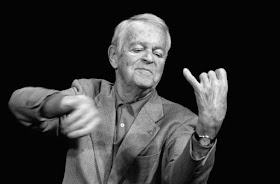Svend Asmussen (28 February 1916 – 7 February 2017) was a
jazz violinist from Denmark, known as "The Fiddling Viking". A Swing
style virtuoso, he played and recorded with many of the greats of Jazz,
including Duke Ellington, Benny Goodman and Stephane Grappelli. He played
publicly until 2010 when he had a blood clot, his career having spanned eight
decades.
Asmussen was born in Copenhagen, Denmark, raised in a
musical  family, and started taking violin lessons at the age of 7. At age 16 he
first heard recordings by jazz violin great Joe Venuti and began to emulate his
style. He started working professionally as a violinist, vibraphonist, and
singer at age 17, leaving his formal training behind for good. Early in his
career he worked in Denmark and on cruise ships with artists such as THE Mills Brothers,
Josephine Baker and Fats Waller.
family, and started taking violin lessons at the age of 7. At age 16 he
first heard recordings by jazz violin great Joe Venuti and began to emulate his
style. He started working professionally as a violinist, vibraphonist, and
singer at age 17, leaving his formal training behind for good. Early in his
career he worked in Denmark and on cruise ships with artists such as THE Mills Brothers,
Josephine Baker and Fats Waller.
 family, and started taking violin lessons at the age of 7. At age 16 he
first heard recordings by jazz violin great Joe Venuti and began to emulate his
style. He started working professionally as a violinist, vibraphonist, and
singer at age 17, leaving his formal training behind for good. Early in his
career he worked in Denmark and on cruise ships with artists such as THE Mills Brothers,
Josephine Baker and Fats Waller.
family, and started taking violin lessons at the age of 7. At age 16 he
first heard recordings by jazz violin great Joe Venuti and began to emulate his
style. He started working professionally as a violinist, vibraphonist, and
singer at age 17, leaving his formal training behind for good. Early in his
career he worked in Denmark and on cruise ships with artists such as THE Mills Brothers,
Josephine Baker and Fats Waller.
Asmussen later was greatly influenced by Stuff Smith,
whom he met in Denmark. Asmussen played with Valdemar Eiberg and Kjeld Bonfils
during World War II, during which time jazz had moved to the underground and
served as a form of political protest.
In the late 1950s, Asmussen formed the trio Swe-Danes with singer Alice Babs and guitarist Ulrik Neumann. The group became very
popular in Scandinavia for their music hall style entertainment and also toured the United States. Asmussen also worked with Benny Goodman, Lionel Hampton, and Duke Ellington. Asmussen was invited by Ellington to play on his Jazz Violin Session recording in 1963 with Stéphane Grappelli and Ray Nance.
In 1966 Asmussen appeared alongside Grappelli, Stuff Smith, and Jean-Luc Ponty in a jazz Violin Summit in Switzerland that was issued as a live recording. He made an appearance at the 1967 Monterey Jazz Festival, which included a
 celebrated violin summit with him, Ray Nance and
Jean-Luc Ponty. In 1969 he guested on "Snakes in a Hole," an album by
the jazz-rock band Made in Sweden. He was still active playing violin at the
age of 94. He turned 100 in February 2016. A few weeks before Asmussen would
have turned 101, on 7 February 2017, he died peacefully in his sleep.
celebrated violin summit with him, Ray Nance and
Jean-Luc Ponty. In 1969 he guested on "Snakes in a Hole," an album by
the jazz-rock band Made in Sweden. He was still active playing violin at the
age of 94. He turned 100 in February 2016. A few weeks before Asmussen would
have turned 101, on 7 February 2017, he died peacefully in his sleep.
















































